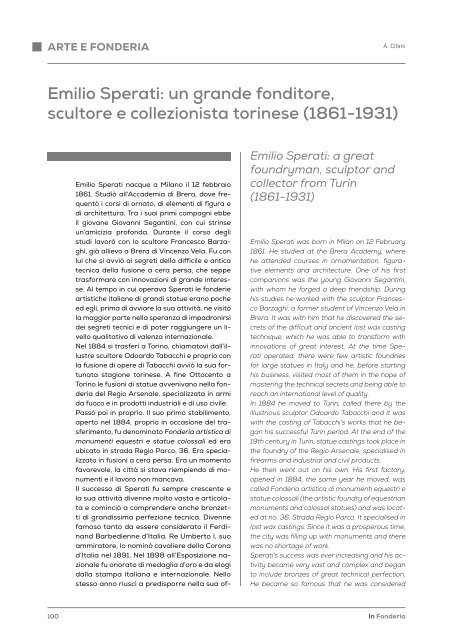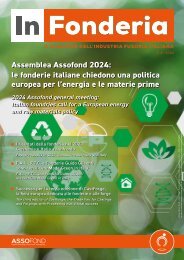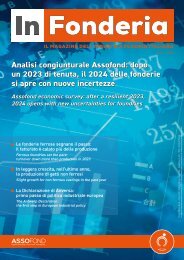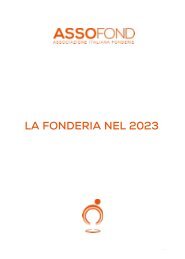In Fonderia 2 2024
Secondo numero del 2024 di In Fonderia
Secondo numero del 2024 di In Fonderia
Create successful ePaper yourself
Turn your PDF publications into a flip-book with our unique Google optimized e-Paper software.
ARTE E FONDERIA<br />
A. Cifani<br />
Emilio Sperati: un grande fonditore,<br />
scultore e collezionista torinese (1861-1931)<br />
Emilio Sperati nacque a Milano il 12 febbraio<br />
1861. Studiò all’Accademia di Brera, dove frequentò<br />
i corsi di ornato, di elementi di figura e<br />
di architettura. Tra i suoi primi compagni ebbe<br />
il giovane Giovanni Segantini, con cui strinse<br />
un’amicizia profonda. Durante il corso degli<br />
studi lavorò con lo scultore Francesco Barzaghi,<br />
già allievo a Brera di Vincenzo Vela. Fu con<br />
lui che si avviò ai segreti della difficile e antica<br />
tecnica della fusione a cera persa, che seppe<br />
trasformare con innovazioni di grande interesse.<br />
Al tempo in cui operava Sperati le fonderie<br />
artistiche italiane di grandi statue erano poche<br />
ed egli, prima di avviare la sua attività, ne visitò<br />
la maggior parte nella speranza di impadronirsi<br />
dei segreti tecnici e di poter raggiungere un livello<br />
qualitativo di valenza internazionale.<br />
Nel 1884 si trasferì a Torino, chiamatovi dall’illustre<br />
scultore Odoardo Tabacchi e proprio con<br />
la fusione di opere di Tabacchi avviò la sua fortunata<br />
stagione torinese. A fine Ottocento a<br />
Torino le fusioni di statue avvenivano nella fonderia<br />
del Regio Arsenale, specializzata in armi<br />
da fuoco e in prodotti industriali e di uso civile.<br />
Passò poi in proprio. Il suo primo stabilimento,<br />
aperto nel 1884, proprio in occasione del trasferimento,<br />
fu denominato <strong>Fonderia</strong> artistica di<br />
monumenti equestri e statue colossali ed era<br />
ubicato in strada Regio Parco, 36. Era specializzato<br />
in fusioni a cera persa. Era un momento<br />
favorevole, la città si stava riempiendo di monumenti<br />
e il lavoro non mancava.<br />
Il successo di Sperati fu sempre crescente e<br />
la sua attività divenne molto vasta e articolata<br />
e cominciò a comprendere anche bronzetti<br />
di grandissima perfezione tecnica. Divenne<br />
famoso tanto da essere considerato il Ferdinand<br />
Barbedienne d’Italia. Re Umberto I, suo<br />
ammiratore, lo nominò cavaliere della Corona<br />
d’Italia nel 1891. Nel 1898 all’Esposizione nazionale<br />
fu onorato di medaglia d’oro e da elogi<br />
dalla stampa italiana e internazionale. Nello<br />
stesso anno riuscì a predisporre nella sua of-<br />
Emilio Sperati: a great<br />
foundryman, sculptor and<br />
collector from Turin<br />
(1861-1931)<br />
Emilio Sperati was born in Milan on 12 February<br />
1861. He studied at the Brera Academy, where<br />
he attended courses in ornamentation, figurative<br />
elements and architecture. One of his first<br />
companions was the young Giovanni Segantini,<br />
with whom he forged a deep friendship. During<br />
his studies he worked with the sculptor Francesco<br />
Barzaghi, a former student of Vincenzo Vela in<br />
Brera. It was with him that he discovered the secrets<br />
of the difficult and ancient lost wax casting<br />
technique, which he was able to transform with<br />
innovations of great interest. At the time Sperati<br />
operated, there were few artistic foundries<br />
for large statues in Italy and he, before starting<br />
his business, visited most of them in the hope of<br />
mastering the technical secrets and being able to<br />
reach an international level of quality.<br />
<strong>In</strong> 1884 he moved to Turin, called there by the<br />
illustrious sculptor Odoardo Tabacchi and it was<br />
with the casting of Tabacchi’s works that he began<br />
his successful Turin period. At the end of the<br />
19th century in Turin, statue castings took place in<br />
the foundry of the Regio Arsenale, specialised in<br />
firearms and industrial and civil products.<br />
He then went out on his own. His first factory,<br />
opened in 1884, the same year he moved, was<br />
called <strong>Fonderia</strong> artistica di monumenti equestri e<br />
statue colossali (the artistic foundry of equestrian<br />
monuments and colossal statues) and was located<br />
at no. 36, Strada Regio Parco. It specialised in<br />
lost wax castings. Since it was a prosperous time,<br />
the city was filling up with monuments and there<br />
was no shortage of work.<br />
Sperati’s success was ever increasing and his activity<br />
became very vast and complex and began<br />
to include bronzes of great technical perfection.<br />
He became so famous that he was considered<br />
100 <strong>In</strong> <strong>Fonderia</strong>














